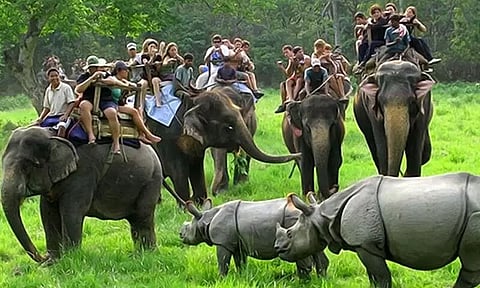
- Home
- Live Blog
- Breaking News
- Top Headlines
- Cities
- NE News
- Sentinel Media
- Sports
- Education
- Jobs

GUWAHATI: Assam government will open Kaziranga National Park to visitors and tourists from October 1 after COVID-19 cases have fallen in the state.
Chief Minister Himanta Biswa Sarma has informed that the government has been trying to unlock COVID-19 restrictions completely to resume normal economic activities in the state.
A 15-kilometres road has been opened for tourists at Bagcher Hills in the National Park.
The COVID-19 pandemic, the resultant economic fallout and the ensuing restrictions could not foil the spirit of around two lakh tourists, including 570 foreigners, from visiting the Kaziranga National Park and Tiger Reserve (KNP & TR) in Assam.
The Director of the UNESCO world heritage site, Karmashree P. Sivakumar, said that since the park-cum-tiger reserve was reopened on October 21 last year, as many as 1,98,595 tourists, including 570 foreign nationals, have visited KNP & TR in the six months till April 21.
The authorities of KNP & TR, extending across five districts of Assam – Golaghat, Nagaon, Sonitpur, Biswanath and Karbi Anglong – along the Arunachal Pradesh border, earn Rs 5 crore on an average each season.
"Around 1.74 lakh tourists, including 11,595 foreigners, had visited the park during the corresponding period of 2019-20. Thousands of more tourists are expected to visit Kaziranga before it is closed ahead of the monsoon," Sivakumar said.
In April, the officials had successfully translocated three rhino calves, two females and one male, which were rescued two years ago during the floods, to the Manas Tiger Reserve (MTR) in western Assam.
With a vast history and mystery behind its name, the Kaziranga National Park is one of the UNESCO World Heritage Sites in India recognized for its unique natural environment. Its entire land coverage is approximately 430 square kilometers comprising rich sedimentary meadows, silty savanna forests, lush misty mixed deciduous woodlands, and dense semi-evergreen woodlands.
It is crisscrossed by 4 primary rivers which also include the river Brahmaputra. This national park is endowed with some of the common species of flora namely, elephant grass, sugarcanes, kumbhi, cougon grass, common reed,Indian gooseberry, talaumahodgsonii, duabanga grandiflora, aphania rubra, and leea indica.